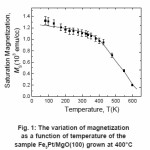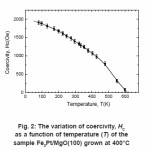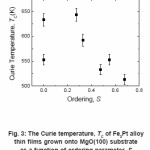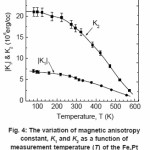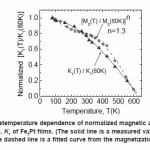M. A. I. Nahid1 and Takao Suzuki2
1Department of Applied Physics and Electronic Engineering, Rajshahi University, Bangladesh.
2MINT, University of Alabama, USA.
DOI : http://dx.doi.org/10.13005/msri/080105
Article Publishing History
Article Received on : 30 Apr 2011
Article Accepted on : 06 Jun 2011
Article Published :
Plagiarism Check: No
Article Metrics
ABSTRACT:
The Fe3Pt alloy thin films were grown on MgO substrates at the various growth temperatures by e-beam evaporation in a high vacuum. The magnetic properties such as saturation magnetization, coercivity, magnetic anisotropy etc. of the Fe3Pt alloy thin films were studied as a function of temperature varying in the range of 80K to 600K. At low temperature (80K), the Fe3Pt films possessed giant cubic magnetic anisotropy (K1≈7×106 erg/cc and K2≈2.2×107 erg/cc). The magnetic anisotropy constants of Fe3Pt films were found to decrease slowly with temperature and vanished at Curie temperature. The Curie temperature of Fe3Pt thin films were also studied as a function of ordering. It was observed that higher ordered sample exhibited lower Curie temperature. PACS : 75.30.Gw
KEYWORDS:
Magnetic anisotropy; Fe3Pt; Ordering etc
Copy the following to cite this article:
Nahid M. A. I, Suzuki T. Giant Magnetic Anisotropy of Fe3Pt Thin Films At Low Temperature. Mat.Sci.Res.India;8(1)
|
Introduction
Among the various binary alloys, Fe3Pt alloys are interesting alloy to study because of its interesting behavior and properties. The Fe3Pt alloy was reported to exhibit the so-called invar properties of anomalous thermal expansion coefficients and the large magneto-volume effect.1 The compounds close to Fe3Pt displayed unusually sharp ferromagnetic anomalies in the thermal expansion coefficient and strong magnetostrictive properties.2 Giant magnetostriction was observed in an ordered Fe3Pt single crystal.3 The Curie temperature of Fe3Pt was reported to be sensitive to pressure. The previous experimental observation suggested that the pressure caused to change the degree of ordering and thus the Curie temperature.4 It was reported that exchange coupled nano-composite magnets made from Fe3Pt and FePt showed large energy product, which exceeded the theoretical limit for non-exchange-coupled FePt.5 Theoretical band structure calculations on ordered Fe3Pt revealed strong hybridization between Fe and Pt d-states and a resultant unusually high density of states (DOS) at the Fermi level compared to other strong ferromagnets such as Fe.6-8 Large cubic magnetic anisotropy was observed in Fe3Pt thin films at room temperature.9 Double switching hysteresis curve were obtained in Fe3Pt alloy thin films.10,11 Due to these many interesting phenomena, Fe3Pt has been the focus of study by many researchers. In spite of these extensive works carried out, there are very few works focusing on the temperature dependent magnetic properties especially magnetic anisotropy of Fe3Pt thin films. This breeds the scientific curiosity to investigate its nature and origin. Therefore, the temperature dependent magnetic properties of Fe3Pt thin films were studied in this manuscript.
Experimental
The Fe3Pt thin films were fabricated by electron beam evaporation onto MgO(100) and MgO(111) substrates using Fe and Pt separate targets in a vacuum better than 10-7 Torr. The substrate deposition temperature (TS) was varied from ambient to 550°C. The combined deposition rate was 0.7Å/sec and thickness of the samples was about 50nm. The samples were rotated in order to get the better uniformity of thickness. Film stoichiometry was achieved by controlling the deposition rate of individual elements, Fe (γFe=0.47Å/ sec) and Pt (γPt =0.23Å/sec). All the films were analyzed by the Energy Dispersive X-ray diffraction and the film compositions were found within the range of ±1% from the stoichiometric composition. The in-plane magnetic anisotropy of Fe3Pt alloy thin films were measured by in-plane torque measurements. The entire samples were made circular in shape in order to avoid the shape magnetic anisotropy. The magnetic anisotropy constants, K1 of Fe3Pt films were obtained from the <001> oriented samples grown onto MgO(100) substrate while the magnetic anisotropy constants K2 were obtained from the <111> oriented samples grown onto MgO(111) substrate. The torque measurements were carried out in the temperature range (T) of 80K to 600K. The Curie temperature (TC) of the samples was determined from the temperature dependent magnetization curve.
Results and Discussions
In our earlier paper, we demonstrated the close relationship of magnetic anisotropy constants of Fe3Pt thin films with the structural parameter [9, 12]. The Fe3Pt films grown at 400°C were partially ordered and exhibited maximum magnetic anisotropy at room temperature as reported earlier.9 In this paper, the temperature dependent magnetic properties such as saturation magnetization, coercivity, magnetic anisotropy constant etc. of Fe3Pt thin films were studied. Measurements were carried out in the range from 80K to 600K. Fig. 1 shows the temperature dependence of saturation magnetization (MS). At 80K, the saturation magnetization, MS was about 1300 emu/cc and diminished at about 625K. The coercivity (HC) of Fe3Pt alloy thin films as a function of temperature was depicted in fig. 2. The maximum coercivity was obtained at 80K of about 2 KOe. The magnetization and the coercivity fell in similar fashion with the temperature.
The Curie temperature was determined from the inflection point of M vs. 1/T plot. The Curie temperature, TC for the partially ordered (S=0.3) case was found about 625K (352°C). The result of TC as a function of the ordering parameter, S is shown in Fig. 3. The ordering parameter was estimated according to ref.9 It was observed that the Curie temperature decreased with the degree of ordering, although, there was a scatter in the data at S=0. The reason of this decrement of TC with the ordering was not clearly understood. However, the nearest neighbor occupancy probabilities and the change of atomic interactions from disordered to ordered state13 or the pair-ordering mechanism might be the origin of the change in Curie temperature. It is known that pair-ordering originates from the unbalanced distribution of the atoms.14, 15 In Fe3Pt alloy, three kinds of atomic pairs are possible such as Fe-Fe, Fe-Pt or Pt-Pt. As only Fe is magnetic, the interaction energy (dipolar and quadrapolar) is believed to depend mainly on the number of Fe-Fe pairs. The numbers of pairs depend on the order parameter that is controlled by growth temperature. The number of Fe-Fe planer pairs in Fe3Pt alloy is found to decrease with the ordering by simple calculations,12 which might be related with this decrement of the Curie temperature in the present case. The Curie temperature for the highest ordered sample (S=0.67) was obtained of about 513K (240°C), a little bit larger than that (435K, 162°C) for the bulk ordered Fe3Pt.
The temperature (T) dependence of K1 and K2 of Fe3Pt thin films grown at 400ºC were investigated over a range from 80K to 600K. The 4-fold and 6-fold symmetry torque curves were observed over the entire temperature range for the two-oriented samples grown on MgO substrates. However, a change in the torque amplitude was noticed with temperature. The magnetic anisotropy constants, K1 and K2 were found to decrease with the increasing T as shown in Fig. 4. When the measurement temperature approached towards the Curie temperature (measured value of Curie temperature of the Fe3Pt film was about 600K), both the magnetic anisotropy constants K1 and K2 gradually vanished similar to other ferromagnetic material. According to the previous theory, the power law dependence of magnetization can be expressed as,19-21 K1(T)/K1(0)=M(T)/M(0)n , where M(0) and M(T) are the magnetization at temperature 0K and T. We employed K1(T)/K1(80K)=M(T)/M(80K)n and numerically fitted our data. From the best fitted value as shown in fig.5, the exponent, n=1.3 was obtained. This value of n was smaller as predicted by Zener and Carr. According to those theories, the value of n would be 3 and 10 for uniaxial and cubic cases respectively. This kind of unexpected dependence of magnetic anisotropy was also observed in other materials22-24. Further theoretical framework is necessary to explain this behavior. However, from the nature of the slow decrement, one can say that the magnetic anisotropy energy of Fe3Pt films is more stable than other transition metal alloys in a wide range of temperature.
Figure 1: The variation of magnetization as a function of temperature of the sample Fe3Pt/MgO(100) grown at 400°C
Figure 2: The variation of coercivity, HC as a function of temperature (T) of the sample Fe3Pt/MgO(100) grown at 400°C
Figure 3: The Curie temperature, TC of Fe3Pt alloy thin films grown onto MgO(100) substrate as a function of ordering parameter, S
Figure 4: The variation of magnetic anisotropy constant, K1 and K2 as a function of measurement temperature (T) of the Fe3Pt alloy thin films grown onto MgO substrates
Figure 5: The temperature dependence of normalized magnetic anisotropy constant, K1 of Fe3Pt films. (The solid line is a measured value while the dashed line is a fitted curve from the magnetization)
Conclusions
In this manuscript, the temperature dependent magnetic properties of the Fe3Pt thin films grown on MgO substrates were studied in the temperature range varying from 80K to 600K. At 80K, the saturation magnetization (MS) and coercivity (HC) of Fe3Pt films (grown at 400ºC) were obtained about 1300 emu/cc and 2000 Oe. Both MS and HC dropped in similar fashion with temperature. The Curie temperature of Fe3Pt films as a function of ordering was investigated and it was found to decrease with the ordering. The reason was yet to be cleared up. However, we believe that the pair ordering mechanism might be the origin of this decrement. The important result was in the case of magnetic anisotropy. The Fe3Pt films (grown at 400°C) at 80K possessed a very large magnetic anisotropy constant. The in-plane magnetic anisotropy constants, K1 and K2 obtained were about -7×106erg/cc and 2.2×107erg/cc respectively. Therefore, the magnetic anisotropy constants of Fe3Pt films at lower temperature (80K) were little bit larger in compare to the room temperature values. Both the magnetic anisotropy constants of Fe3Pt thin films dropped with temperature with the 1.3 power of magnetization. It was relatively slower rate in the case of cubic magnetic anisotropy as predicted by the theory. Thus, the magnetic anisotropy constants were found stable in a wide range of temperature.
Acknowledgements
The author greatly acknowledges the support of Toyota Technological Institute and the Grant-in-Aid for the Academic Frontier Project from the Ministry of Education, Culture, Sports, Science and Technology, Japan.
References
- K. Sumiyama, M. Shiga, M. Morioka and Y. Nakamura, J. Phys, F9: 1665 (1979).
CrossRef
- Kussm Tan, Auwarter and Rittenberger, Ann. Physik, 4: 176 (1948).
- T. Kakeshita, T. Takeuchi, T. Fukuda, M. Tsujiguchi, T. Saburi, R. Oshima, and S. Muto, Appl. Phys. Lett., 77: 1502 (2000).
CrossRef
- Gendo Oomi and H. Araki, J. Magn. Magn.Mater, 140: 83 (1995).
CrossRef
- H. Zeng, J. Li, J.P. Liu, Z. L. Wang, S. Sun,Nature, 40: 395 (2002).
CrossRef
- M. Podgorney, Phys. Rev. B, 43: 11300 (1991).
CrossRef
- K. J. Kim, S. J. Lee, T. A. Wiener, and D. W. Lynch, J. Appl. Phys., 89: 244 (2001).
CrossRef
- A. Hasegawa, J. Phys. Soc. Jpn., 54: 1477 (1985).
CrossRef
- M. A. I. Nahid and T. Suzuki, Appl. Phy. Lett.,85: 4100 (2004).
CrossRef
- M. A.I. Nahid and T. Suzuki, Thin Solid Films,516: 2063 (2008).
CrossRef
- J. Yin, T. Suzuki, M. A. I. Nahid and L. Pan, J. Phys. D: Appl. Phys., 41: 185004 (2008).
CrossRef
- M. A. I. Nahid and T. Suzuki, J. Appl. Phys.,97: 10K307 (2005).
- L. Wang, Z. Fan, A.G. Roy, and D.E. Laughlin,J. Appl. Phys., 95: 7583 (2004).
- L. Neel, J. Phys. Radium, 15: 225 (1954).
CrossRef
- S.Chikazumi, Physics of Ferromagnetism (Oxford Science Publications, USA) 258 (1997).
- C. Zener, Phys. Rev., 96: 1335 (1954).
CrossRef
- W. J. Carr, Phys. Rev., 109: 1971 (1958).
CrossRef
- H. B. Callen and E. Callen, J. Phys. Chem. Solids, 27: 1271 (1966).
CrossRef
- X. W. Wu, K. Y. Guslienko, R. W. Chantrell, and D. Weller, Appl. Phys. Lett., 82: 3475 (2003).
CrossRef
- J.-U. Thiele, K. R. Coffey, M. F. Toney, J. A. Hedstrom, and A. J. Kellock, J. Appl. Phys., 91: 6595 (2002).
CrossRef
- S. Okamoto, N. Kikuchi, O. Kitakami, T. Miyazaki, Y. Shimada, and K. Fukamichi, Phys. Rev. B, 66: 024413 (2002).
CrossRef

This work is licensed under a Creative Commons Attribution 4.0 International License.
 Material Science Research India An International Peer Reviewed Research Journal
Material Science Research India An International Peer Reviewed Research Journal

